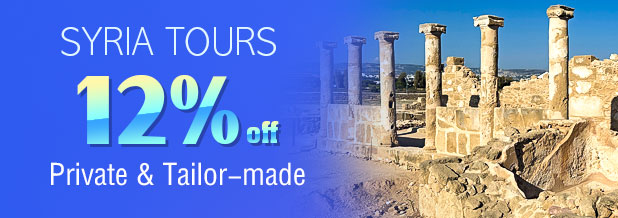- Top 9 Things to Do
- Transportation
- Travel Tips
Top 9 Things to Do in Syria
1. The Umayyad Mosque
The Umayyad Grand Mosque, founded in 705 in Damascus, the Syrian capital, is one of the most important mosques in Islam. The temple is considered to be the fourth largest holy shrine in Islam. The Umayyad Mosque was originally the Temple of Jupiter during the Roman Empire Period and was later renamed St. John's Cathedral to commemorate John the Baptist after the Roman Empire established Christianity as the state religion. After Syria was conquered by the Arabs in the 7th century, the Cathedral of St. John was still used by Christians. In 705, the caliph Walid I of the Umayyad dynasty took over the church and changed it to a mosque. Walid I recruited artisans from Byzantium, Syria, and Egypt to complete the mosque in ten years.2. Krak des Chevaliers
Krak des Chevaliers, located east of Tartus, Syria, is one of the most important preserved medieval castles in the world. The 11th-century Kurds lived here, and referred to here as "Hisn al Akrad", meaning the Kurdish castle. In 1142, Raymond II of Tripoli gave it to the Knights Hospitaller. The Knights Hospitaller owned it until it was conquered in 1271. In 2006, Krak des Chevaliers was recognized as a UNESCO World Heritage Site.3. The Azm Palace
The Azm Palace is a palace in Damascus, Syria, built in 1749 as the residence of Governor As’ad Pasha al-Azm of Damascus during the Ottoman Empire Period. It is now a museum of traditional art. The building is a good example of traditional Damascus houses. The complex consists of two parts: the "harem" and the "selamlik". The harem is a private space where family members live, including kitchens, servant dormitories, and bathrooms. The selamlik includes the main hall, reception hall, and a huge courtyard with large fountains.4. National Museum of Damascus
The National Museum of Damascus is Syria’s largest museum, located in the western part of the city, between the Damascus University and the Tekkiye Mosque. The most popular part of the museum is the reconstructed Dura-Europos Synagogue of the 2nd century. The museum was founded in 1919. The current building was built in 1936 and expanded in 1956 and 1975. The exhibits are divided into 5 parts:Prehistoric times:
relics and skeletons of different stone ages.
Ancient Syria:
exhibits from ancient ruins, among which the most important is the first letter in the world.
Classical era:
This section contains Roman, Greek and Byzantine exhibits, including many rare statues, as well as stone and marble sarcophagi. It also includes a jewelry museum.
Islamic times:
The facade of an Islamic palace was moved here as the main entrance to the museum. Some of the sculptures in the palace were also exhibited in the museum. It also displays literature from the Umayyad Period to the Ottoman Empire Period. There is also a showroom showing a traditional Syrian family with exhibits from an 18th-century house.
Contemporary:
Contains contemporary works of art by artists from Syria and other Arabic countries.
5. Khan As'ad Pasha
Khan As'ad Pasha is the largest khan in Damascus, built in the middle of the 18th century, named after the then governor of Damascus, As'ad Pasha al-Azm.6. Ancient City of Aleppo
The ancient city of Aleppo refers to the historical downtown part of Aleppo. Many regions maintained their original appearance from the 12th to the 16th century. Each district has its own characteristics according to the religion and ethnic characteristics of the residents. Famous tourist attractions include Al-Madina Souq, the Citadel of Aleppo, the Great Mosque of Aleppo, Al-Shibani Church, Al-Halawiyah Madrasa, and the Forty Martyrs Cathedral.7. Maktab Anbar
Maktab Anbar is an old mansion in the heart of the old city of Damascus, close to Umayyad Mosque and Damascus Straight Street. This is a private residence built by Mr. Anbar, a native Jew in the middle of the 19th century. There are three courtyards: the first is the formal guest yard, then the pretty harem courtyard, and finally the plain servant's courtyard. The main part of the project is huge in size. Mr. Anbar gave up building the house in 1887 because of excessive expenses. The Ottoman Empire, which ruled Syria later, completed the project and added two wings to turn it into a men's school. The Syrian Ministry of Culture repaired it in 1976. Now we can see a library, an exhibition hall, museums and craft workshops.8. Bab Sharqi
Bab Sharqi, also known as the Gate of the Sun, is one of the eight ancient city gates in Damascus and the only surviving ancient Roman city gate. It is named after its location on the eastern side of the city.9. Ruad Island
Ruad Island is a small island on the Syrian coast in the eastern Mediterranean. It is the only inhabited island in Syria and is 3 km (2 miles) east of Syria’s largest port Tartus. It has a long history and its name appears in ancient books such as the Bible. Historically, the island was an important commercial, fishing, and navigation center. It was also an important military fortress. It was once ruled by Phoenicians, Greeks, and Crusades. In 1302, the area was conquered by Mamluk as the last stronghold of the Crusaders.
You May Like:
Syria Transportation Syria Travel Tips

